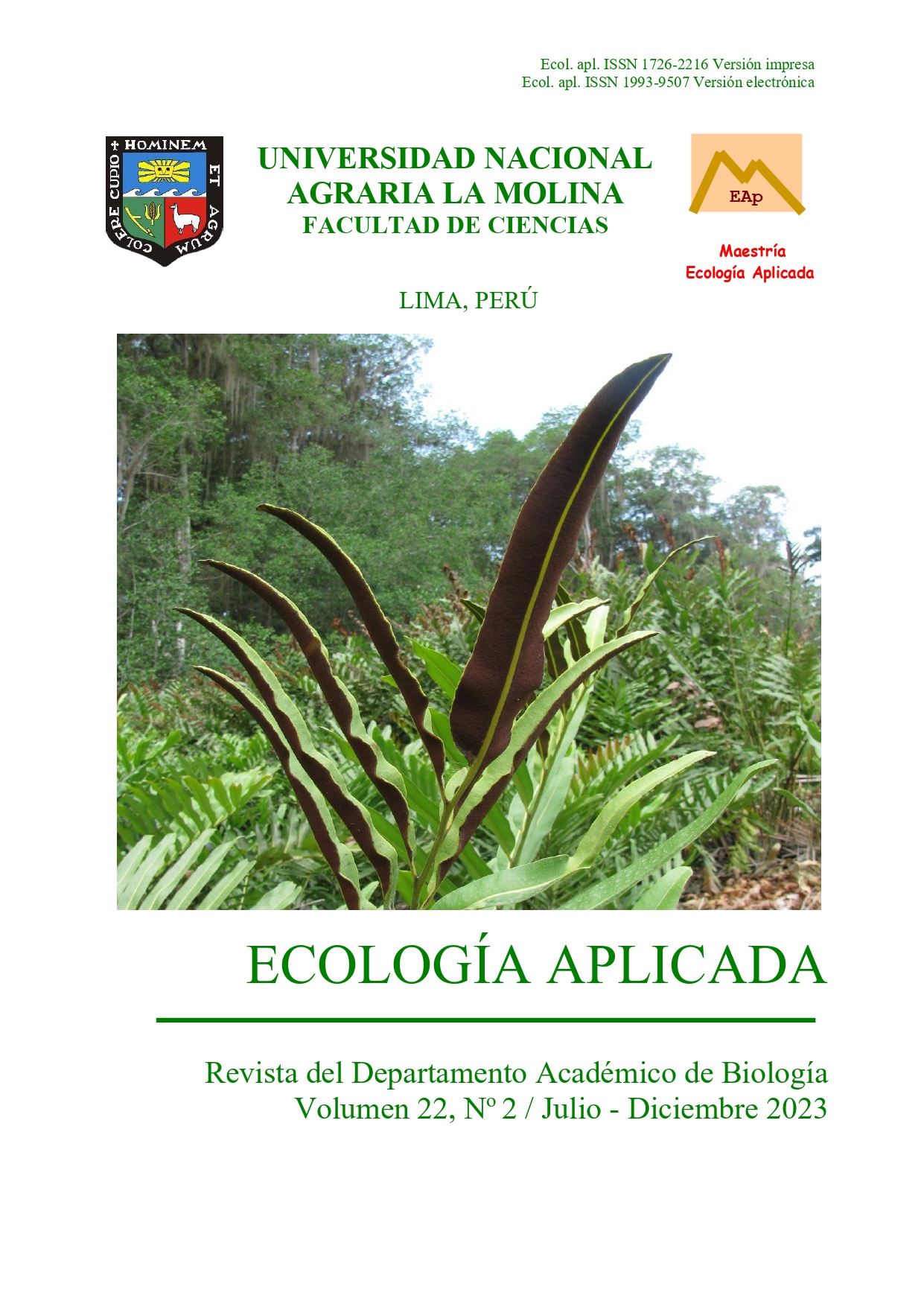ECOLOGICAL NICHE OF Anchoa nasus “SAMASA” IN PISCO BAY (PERÚ)
DOI:
https://doi.org/10.21704/rea.v22i2.2084Keywords:
Anchoa nasus, samasa, ecological niche, temperature, salinity, oxygen, chlorophyllAbstract
The objective of the present work was to determine the effects of temperature, salinity, oxygen and chlorophyll a on the relative abundance of Anchoa nasus “samasa” in the Pisco area, during the years 2011-2017. For this, biometrical samplings were carried out, oceanographic surveys and information of catches and fishery effort were collected. Relative abundance data were related to environmental factors data using Generalized Additive Models (GAM), the lower and upper limits of the ecological niche was calculated using the Integrated Nested Laplace Approximation (INLA) method. In order to identify temporal phases during the study period Principal Component Analysis, Classfication Analysis and Ordicluster between dates based on environmental variables were carried out. The ecological niche of samasa in relation to surface temperature was found between 18.15 °C and 21.56 °C, in relation to surface salinity between 34.915 and 35.070, regarding chlorophyll a presented a lower limit of 8.59 mg· m-3, and regarding dissolved oxygen presented a lower limit of 8.02 m· l-1 for surface level. Compared to other species, the ecological niche of was located in mesophilic, marine, normoxic and mesotrophic conditions.
Downloads
References
Ayala-Pérez L.A., Rojas-Galaviz J.L. & Avilés-Alatriste O.A. 1997. Crecimiento, reproducción y dinámica poblacional de Anchoa mitchilli (Pisces: Engraulidae) en el sistema Palizada-Del Este, Campeche, México. Revista de Biología Tropical, 45(1): 507-518. https://revistas.ucr.ac.cr/index.php/rbt/article/view/30660.
Barber R.T. & Chavez F.P. 1983. Biological Consequences of El Niño. Science, 222(4629): 1203-1210. https://www.science.org/doi/10.1126/science.222.4629.1203.
Bertrand A., Chaigneau A., Peraltilla S., Ledesma J., Graco M., Monetti F. & Chavez F.P. 2011. Oxygen: A Fundamental property regulating pelagic ecosystem structure in the coastal southeastern tropical Pacific. PLoS ONE, 7(2): e29558. https://journals.plos.org/plosone/article?id=10.1371/journal.pone.0029558.
Borcard D., F. Gillet & Legendre P. 2011. Numerical ecology with R. Springer. https://doi.org/10.1007/978-1-4419-7976-6.
Bouchon M. 2007. Biología y pesquería de samasa Anchoa nasus (Kner y Steindachner, 1866) (Pisces: Clupeiformes: Engraulidae) en el mar peruano. Tesis de Maestría. Escuela Universitaria de Postgrado. Universidad Nacional Federico Villarreal. Perú.https://repositorio.imarpe.gob.pe/bitstream/20.500.12958/2330/1/Bouchon%2c%20Maril%c3%ba.pdf.
Chirichigno N. & Cornejo R.M. 2001. Catálogo comentado de los peces marinos del Perú. Publicación Especial Inf. Inst. Mar Perú.
Diaz R.J. & Rosenberg R. 1995. Marine benthic hypoxia: A review of its ecological effects and the behavioural responses of benthic macrofauna. Oceanogr. & Mar. Biol., 33: 245–303. https://bit.ly/rEA-UNALM-15.
Hastie T.J. & Tibshirani R.J. 1990. Generalized Additive Models. 1st Edition. Chapman & Hall. https://doi.org/10.1201/9780203753781.
Hutchinson G.E. 1944. Limnological studies in Connecticut. VII. A critical examination of the supposed relationship between phytoplankton periodicity and chemical changes in lake waters. Ecology, 26(1): 3–26. https://doi.org/10.2307/1930759. https://www.jstor.org/stable/1930759.
Jordán R. & Chirinos A. 1965. La Anchoveta (Engraulis ringens J.): conocimiento actual sobre la biología, ecología y pesquería. Inf. Inst. Mar Perú, (6): 1-52. https://hdl.handle.net/20500.12958/235.
Ledesma J., Graco M., Tam J., Díaz K., Anculle T., García W., Bernales A., Quispe D., Espinoza D., Carhuapoma W. & Gutiérrez D. 2021. Efectos de El Niño Costero 2017 sobre la oxigenación, fertilidad y productividad del mar frente a las costas del Perú. Bol Inst. Mar Perú, 36(2): 409-427. https://repositorio.imarpe.gob.pe/bitstream/20.500.12958/4239/1/Boletin%2036-2%20articulo6.pdf.
Luján D. 2016. Factores determinantes de la variabilidad espacial de anchoveta peruana (Engraulis ringens) en el Pacífico sudoriental. Tesis para optar el grado de Maestro en Ciencias del Mar. Universidad Peruana Cayetano Heredia. Lima. https://repositorio.imarpe.gob.pe/bitstream/20.500.12958/3031/1/Lujan%20Paredes%2c%20C.pdf.
Martínez R. 2012. Efecto de la variabilidad ambiental en la distribución de las capturas incidentales de pelágicos mayores en el océano Pacifico oriental. Tesis doctoral en Ciencias Marinas. Instituto Politécnico Nacional. La Paz, México. https://tesis.ipn.mx/bitstream/handle/123456789/18455/martinezr2.pdf?sequence=1&isAllowed=y.
Martos P., Hansen J., Negri R. & Madirolas A. 2005. Factores oceanográficos relacionados con la abundancia relativa de anchoíta (Engraulis anchoita) sobre la plataforma bonaerense (34° S - 41° S) durante la primavera. Revista de Investigación y Desarrollo Pesquero, 17: 5-33. http://hdl.handle.net/1834/1559.
Martino S. & Rue H. 2009. Implementing Approximate Bayesian Inference using Integrated Nested Laplace Approximation: a manual for the inla program. https://inla.r-inla-download.org/r-inla.org/doc/inla-manual/inla-manual.pdf.
Moreno D.P., Quintero J. & López A. 2010. Métodos para identificar, diagnosticar y evaluar el grado de eutrofia. Revista Contactos, 78: 25–33. http://www2.izt.uam.mx/newpage/contactos/anterior/n78ne/eutrofia2.pdf.
Morón O., Flores G., Sánchez S. & Girón M. 1997. Monitoreo oceanográfico pesquero en áreas seleccionadas Paita- Chimbote-Callao-Pisco-Ilo, setiembre 1996 (MOPAS 9609). Informe Progresivo. Informe Progesivo 50. IMARPE. https://repositorio.imarpe.gob.pe/bitstream/20.500.12958/955/1/IP%2050.pdf.
Morón O., Quispe J., Lorenzo A., Flores G., Sánchez S., Aronés K., Solís J. & Quipuzcoa L. 2017. Caracterización de los procesos físicos, químicos, biológicos y sedimentológicos en las islas Ballestas y Chincha. 2013. Informe Instituto Mar Perú, 44(4): 472-506. https://hdl.handle.net/20.500.12958/3229.
Ministerio de la Producción. 2001. Resolución Ministerial Nº 209-2001-PE: Aprueban relación de tallas mínimas de captura y tolerancia máxima de ejemplares juveniles principales de peces marinos e invertebrados. El Peruano, [Lima, miércoles 27 de Junio 2001] 19(7675): 205170-205171. https://busquedas.elperuano.pe/download/full/CYeijhtz4Wc8hg5doNZNRI.
Mitsch W. & Gosselink J.G. 1993. Wetlands. Second Edition. Van Nostrand Reinhold. New York.
NASA 2023. Ocean color. Level 3 & 4. https://oceancolor.gsfc.nasa.gov/l3/.
Pennington J.T., Mahoney K.L., Kuwahara V.S., Koler D.D., Calienes R. & Chavez F.P. 2006. Primary production in the eastern tropical Pacific: A review. Progress in Oceanography, 69(2-4): 285–317. doi: 10.1016/j.pocean.2006.03.012.
Pasache-Medina M., Tam-Málaga J., Calle-Estrada E., Vásquez-Velasco C., Arones-Cahua I. & Lorenzo-Puitiza A. 2021. Índice multivariado de la salud de la samasa Anchoa nasus en la Bahía de Pisco (Ica-Perú). Ciencia Pesquera, 29(1-2): 31-39. https://www.gob.mx/cms/uploads/attachment/file/687903/Ciencia_pesquera_29_-_1_y_2.pdf.
Peterson C.L. 1956. Observations on the taxonomy, biology, and ecology of the Engraulid and Clupeid fishes in the Gulf of Nicoya, Costa Rica. Inter-American Tropical Tuna Commission Bulletin, 1(5): 137-282. http://hdl.handle.net/1834/20730.
Pietri A., Colas F., Mogollon R., Tam J. & Gutierrez D. 2021. Marine Heat Waves in the Humboldt Current System: from 5-day localized warming to year-long El Niños. Scientific Reports, 11: 21172. https://doi.org/10.1038/s41598-021-00340-4.
Quispe-Ccalluari C., Tam J., Demarcq H., Chamorro A., Espinoza-Morriberón D., Romero C., Dominguez N., Ramos J. & Oliveros-Ramos R. 2018. An index of coastal thermal effects of El Niño Southern Oscillation on the Peruvian Upwelling Ecosystem. Int. J. Climatol., 38(7): 3191-3201. https://doi.org/10.1002/joc.5493.
R Core Team. 2019. The R Project for Statistical Computing. R Foundation for Statistical Computing. Vienna, Austria. [webpage]. https://www.R-project.org/.
Rue H., Martino S. & Chopin N. 2009. Approximate Bayesian inference for latent Gaussian models by using integrated nested Laplace approximations (with discussion). Journal of the Royal Statistical Society, Series B., 71(2): 319-392. https://rss.onlinelibrary.wiley.com/doi/epdf/10.1111/j.1467-9868.2008.00700.x.
Saldarriaga M. 2015. Análisis de la captura incidental en la pesquería industrial de cerco anchovetera en el litoral peruano durante el período 2003-2011. Tesis Ing. Pesquero. UNALM. https://hdl.handle.net/20500.12958/3032.
Serra R. & Tsukayama I. 1988. Sinopsis de datos biológicos y pesqueros de la sardina, Sardinops sagax en el Pacífico suroriental. Sinopsis sobre la Pesca 13. Rev. 1. FAO. http://www.fao.org/3/a-s8134s.pdf.
Shelford V.E. 1931. Some Concepts of Bioecology. Ecology, 12(3): 455–467. https://www.jstor.org/stable/1928991.
SNP. 2017. Acta de la quinta reunión del grupo de trabajo. https://cedepesca.net/wp-content/uploads/2018/04/2017-11-29_Acta-de-la-quinta-reuni%C3%B3n-del-grupo-de-trabajo.pdf.
Sparre P. & Venema S.C. 1999. Introduction to tropical fish stock assessment. Part 2. Exercises. FAO Fisheries Technical Paper. N° 306/2, Rev. 2. FAO. https://www.fao.org/3/w5449e/w5449e00.pdf.
Vieille C. & Zeikus G.J. 2001. Hyperthermophilic enzymes: sources, uses and molecular mechanisms for thermostability. Microbiol. Mol. Biol. Rev., 65(1): 1-43. https://journals.asm.org/doi/pdf/10.1128/mmbr.65.1.1-43.2001.
Whitehead P.J.P., Nelson G.J. &. Wongratana T. 1988. Clupeoid fishes of the world (SubOrder Clupeoidei). An annotated and illustrated catalogue of the herrings, sardines, pilchards, sprats, shads, anchovies and wolfherrings. Part 2. Engraulididae. FAO species catalogue. FAO Fish. Synop., 7(125), Pt. 2: 305-579. https://www.fao.org/publications/card/es/c/84cef891-8a50-5b0f-bd80-fe52d25dad78/.
Zuta S., Tsukayama I. & Villanueva R. 1983. El ambiente marino y las fluctuaciones de las principales poblaciones pelágicas de la costa peruana. FAO Fish.Rep./FAO Inf.Pesca, 2(291):179-254.
Downloads
Published
Issue
Section
License
Copyright (c) 2024 Gerardo Andrés Pasache Medina, Jorge Tam Málaga, Alberto Lorenzo Puitiza, Guisela Yábar Torres, Italo Arones Cahua

This work is licensed under a Creative Commons Attribution-NonCommercial 4.0 International License.



